Theatre Review
Sierra College Theatre Arts Department
Noises Off
(This show ran Oct. 25 to Nov. 10, 2019. I saw the Sunday matinee performance on Nov. 3.)
It’s been a few years since I’ve seen a performance by the Sierra College Theatre Arts Department. They’ve done good work in the past, but when I entered the theatre on this Sunday afternoon, I wasn’t expecting to see one of the funniest shows I’ve seen in my life.
Noises Off is a comedy written in 1982, a farce by English playwright, Michael Frayn. The idea is to illustrate the deterioration in the relationships among cast and director in the multi-week run of a play. In the process, the audience sees a play within a play, both from the fictional audience’s perspective and from backstage.
Sierra College’s Dietrich Theatre was well attended for this performance. It was introduced by Director and Sierra College faculty member, Debra Hammond. She welcomed the audience, explained a bit about the plot, and warned us of some bad language (though I hardly noticed). I have to add that the director’s hand in a production like this has to be momentous, and I wish now that we all had been warmer in our applause for her after she finished her introduction.
When the curtain rose, I was immediately impressed with the elaborate
set. Dietrich Theatre has a stage that is wide and deep compared to
many other venues, and the set seemed to fill the stage.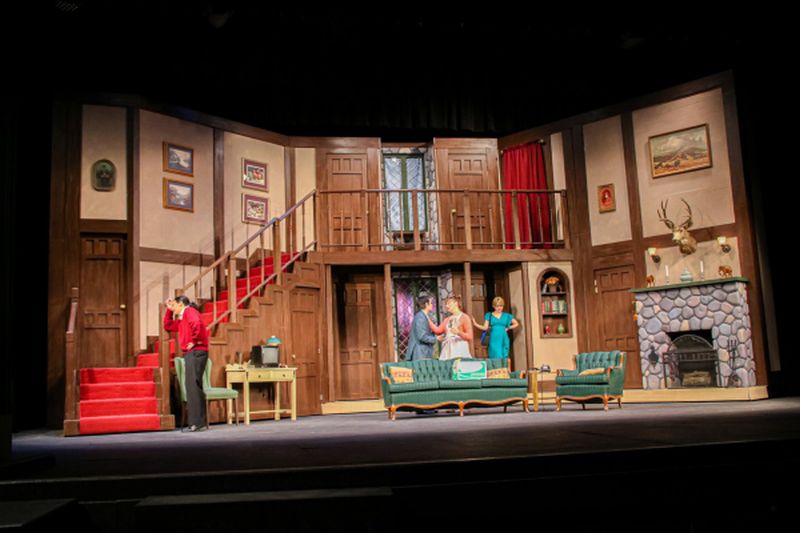 You can see
from the accompanying image how elaborate it was. And the structure was
built on a turntable to show the back of the set for Act II. Besides the
set, the next thing that appealed to me was the quality of the sound. I
heard each actor’s lines clearly ― and my wife claims I’m losing my
hearing!
You can see
from the accompanying image how elaborate it was. And the structure was
built on a turntable to show the back of the set for Act II. Besides the
set, the next thing that appealed to me was the quality of the sound. I
heard each actor’s lines clearly ― and my wife claims I’m losing my
hearing!
(Click here to open the program in a new window.)
The comic tension in Noises Off begins in the first scene as actors and director are rehearsing for their play’s opening on the following day ― and nothing is going right. Maureen Roman was the housekeeper as the action opened, and I marveled at her comic instincts ― and English accent ― which were perfect for her role. She argued with Joseph
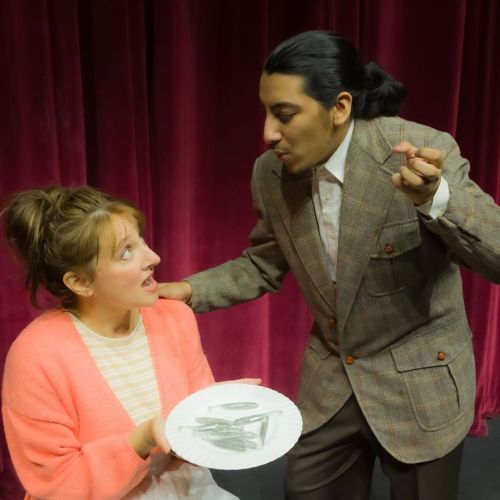 |
| Maureen Roman & Joseph Morales |
Morales as the Director, who delivered his sarcastic comments from behind us in the audience ― and I was convinced he was drawing on quite a bit of experience with directors. (I'm referring to the characters of the play-within-the-play.)
The action was fast-moving, with frequent surprises and occasional outbursts. There were constant arguments and some great physical comedy. In short, I and my fellow audience members laughed our way through Act I. What made the humor work so well? There was so much behind it, as I’ll try to explain below, but for one thing, It felt to me like each character was carefully crafted, with different energy and with each one’s own set of quirks. For example, with his years of experience, John Deaderick played a great drunk… wait, did I say that right? At any rate, I feel that these actors (and this director) deserve as much credit as the playwright for how effective the comedy was.
When the curtain rose on Act II, we were presented with the back of the set that we had watched in Act I. And as the action proceeded, the conflict among the characters escalated. Periodically I was aware of how clever the writing was, but I was more frequently awed by the physical and situational comedy. I wish I could give examples, but everything moved too quickly to allow me to make notes.
Another aspect of the production that seemed fresh and intriguing was the fact that during Act II we could hear and see (through a window in the set) the scene being performed that we had observed in Act I. But the backstage action we saw in front of us was what consumed our attention. In another of the hilarious comic techniques, the performers had to mouth their words and mime their actions. After all there was a play and an audience on the other side of the set! As the clashes among the characters intensified and chaos began to reign, the hilarity intensified. A key feature of this act was the transfer of props and rapid entrances and exits. Honestly, I marveled at the precision with which these actions were carried out. With everyone in character and handling props (and costume items) with the precision of a circus juggler, the “performance” was falling apart. And watching these people trying to hold it together made it all the funnier.
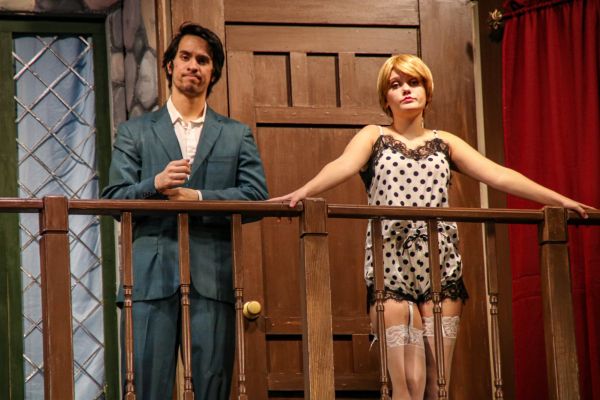 |
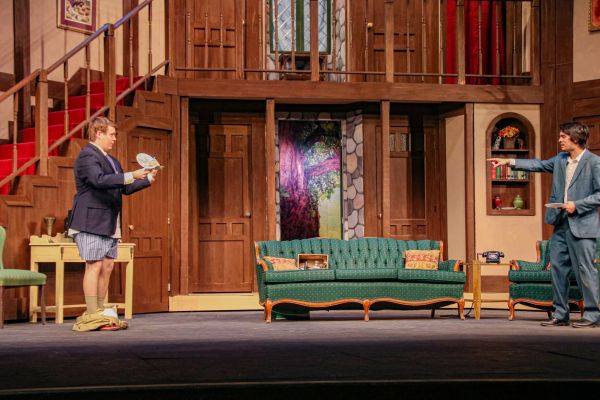 |
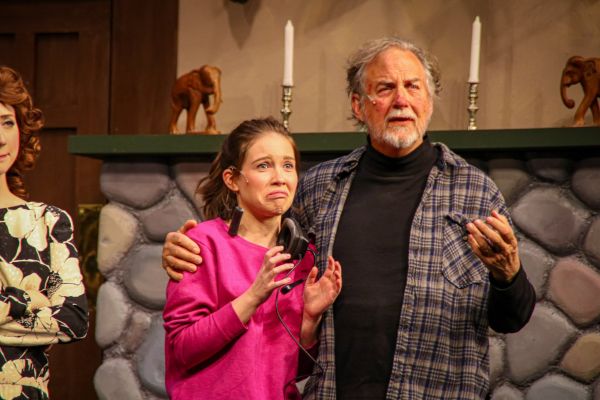 |
| Austyn Crighton & Emma Howard | Willis Peterson & Austyn Crighton | Emily Downs & John Deaderick |
While the audience was waiting for Act III to begin, the curtain suddenly opened, and we were able to see the stagehands rotate the set to its original position. It may have seemed to some like a bit of ostentation, but who cares? It was great stagecraft, and I bet nearly every person in the audience appreciated this peek behind the curtain.
If one could slow this show down and enumerate the various comic devices, I think there would be scores of them. One more took place before the curtain had risen on Act III. There was a whiskey bottle placed just in front of the curtain and about 15 feet from “off right” or the left side of the stage from our perspective. John Deaderick, as the chronically drunk Selsdon Mowbray, appeared at an exit door near the front of the theatre. Slyly he worked his way toward the bottle, only to be scared away when a spotlight was shone on him.
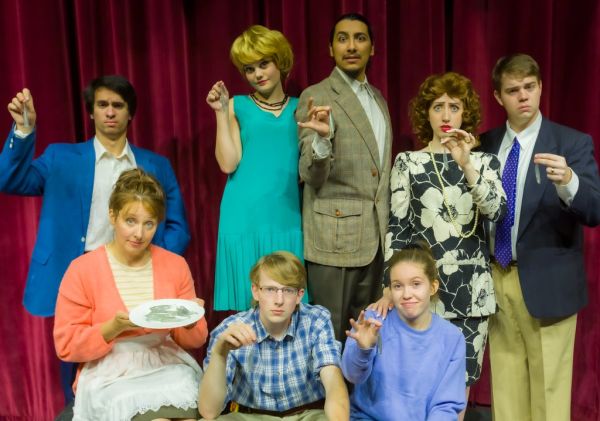 In Act III all pretense of performing the “play within the play”
slowly evaporated. Characters had to improvise or exchange parts to make
up for the absence or non-cooperativeness of other characters. In the
epitome of physical comedy, Austyn Crighton, as Roger Tramplemain, fell
down the long flight of stairs. It was so believable, so perfectly
executed that I bet he could work as a stunt man if the acting thing
doesn’t work out for him. Willis Peterson, as Phillip Brent, was hilarious as, after getting his
foot stomped on, he limped around with his pants down around his legs.
Karin Worley, as Flavia Brent, kept trying to hold it together, but
eventually lost her cool, grabbing the axe from the wall. And Emma
Howard as Vicki, frequently surprised us as she lost her contact,
finding it once “behind her eye.” Emily Downs as the longsuffering stage
manager, made us laugh as she tried to correct the incorrect “minutes to curtain”
announced to the audience by others. Thomas Larkin, as the stage hand,
seemed initially like the stable one until he got enmeshed in the
craziness and brought his own humorous moments. You get my drift? There
were no minor characters in this play; each one carried significant
weight.
In Act III all pretense of performing the “play within the play”
slowly evaporated. Characters had to improvise or exchange parts to make
up for the absence or non-cooperativeness of other characters. In the
epitome of physical comedy, Austyn Crighton, as Roger Tramplemain, fell
down the long flight of stairs. It was so believable, so perfectly
executed that I bet he could work as a stunt man if the acting thing
doesn’t work out for him. Willis Peterson, as Phillip Brent, was hilarious as, after getting his
foot stomped on, he limped around with his pants down around his legs.
Karin Worley, as Flavia Brent, kept trying to hold it together, but
eventually lost her cool, grabbing the axe from the wall. And Emma
Howard as Vicki, frequently surprised us as she lost her contact,
finding it once “behind her eye.” Emily Downs as the longsuffering stage
manager, made us laugh as she tried to correct the incorrect “minutes to curtain”
announced to the audience by others. Thomas Larkin, as the stage hand,
seemed initially like the stable one until he got enmeshed in the
craziness and brought his own humorous moments. You get my drift? There
were no minor characters in this play; each one carried significant
weight.
As I watched Act III, I was enveloped in a sense of awe, an awe that really began early in the second act. I was struck by the complexity of this play: each player inhabiting two characters, the extraordinary number of props to handle, the timing of entrances and interactions so crucial, and the demands of a complex dialog with rapid exchanges. My awe came from observing how flawlessly and artfully it was all managed by these players, most of whom are Sierra College students.
What I and the rest of the audience had witnessed brought us to our feet as actors took their bows. And I left the theatre not only with the high spirits of 2½ hours of almost continuous laughter, but with a renewed respect for the quality of the work of the Sierra College Theatre Arts Department.
(To keep abreast of future productions from Sierra College's Theatre Arts Department, visit this page in the College's website.)
Dick Frantzreb is editor of the Capital Region Performance Gallery. He also edits the Sacramento Choral Calendar and the Placer Performance Calendar, and he was a co-founder and past President of the Sacramento Valley Choral Coalition. He has been loving live performances in the greater Sacramento area and writing about them since 2012.